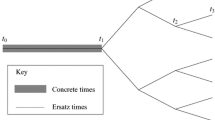Abstract
The Multiverse Thesis is a proposed solution to the Grandfather Paradox. It is popular and well promulgated, found in fiction, philosophy and (most importantly) physics. I first offer a short explanation on behalf of its advocates as to why it qualifies as a theory of time travel (as opposed to mere ‘universe hopping’). Then I argue that the thesis nevertheless has an unwelcome consequence: that extended objects cannot travel in time. Whilst this does not demonstrate that the Multiverse Thesis is false, the consequence should give pause for concern. Even if it does not lead one to reject the thesis, I briefly detail some reasons to think it is interesting nonetheless.
Similar content being viewed by others
References
Abbruzzese J. (2001) On using the multiverse to avoid the paradoxes of time travel. Analysis 61: 36–38
Cartwright, R. (1975). Scattered objects. In: K. Lehrer (Ed.), Analysis and metaphysics (pp. 153–171).
Davies P. (1995) About time. Penguin Books, London
Deutsch D. (1991) Quantum mechanics near closed timelike lines. Physical Review D 44: 3197–3217
Deutsch D., Lockwood M. (1994a) The quantum physics of time travel. Scientific American 270: 68–74
Deutsch D., Lockwood M. (1994b) Deutsch and Lockwood reply. Scientific American 271: 5
Deutsch D. (1997) The fabric of reality. Penguin Books, London
Everett A. (2004) Time travel paradoxes, path integrals, and the many worlds interpretation of quantum mechanics. Physical Review D 69: 124023.1–124023.14
Forrest P. (2004) Grit, Gunk and the Banach–Tarski paradox. The Monist 87: 351–370
Gödel K. (1949) An example of a new type of cosmological solutions of Einstein’s field equations of gravitation. Reviews of Modern Physics 21: 447–450
Gott J. (2001) Time travel in Einstein’s universe: the physical possibilities of travel through time. Orion Books, London
Greene B. (2004) The fabric of the cosmos. Penguin Books, London
Gribbin J. (1992) In search of the edge of time. Penguin Books, London
Hewett L. (1994) Letters to the editor. Scientific American 271: 5
Lewis D., Lewis S. (1970) Holes. Australasian Journal of Philosophy 48: 206–212
Lewis D. (1976) The paradoxes of time travel. American Philosophical Quarterly 13: 145–152
McDaniel K. (2006) Gunky objects in a simple world. Philo 9: 39–46
Morris M., Thorne K., Yurtsever U. (1988) Wormholes, time machines and the weak energy condition. Physical Review Letters 61: 1446–1449
Richmond A. (2003) Recent work: time travel. Philosophical Books 44: 297–309
Tipler F. (1974) Rotating cylinders and the possibility of global causality violation. Physical Review D 9: 2203–2206
Uzquiano G. (2006) Receptacles. Philosophical Perspectives 20: 427–451
Author information
Authors and Affiliations
Corresponding author
Rights and permissions
About this article
Cite this article
Effingham, N. An unwelcome consequence of the Multiverse Thesis. Synthese 184, 375–386 (2012). https://doi.org/10.1007/s11229-010-9820-5
Received:
Accepted:
Published:
Issue Date:
DOI: https://doi.org/10.1007/s11229-010-9820-5



